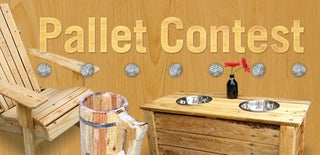Introduction: Pallet Wood Bench and Gabion Table
Green design gives us the opportunity to be extra creative. When materials or objects have served their original purpose, and are put in the category of "waste" (what an absurd concept anyway!), we give them new life by uncover their potential and beauty, and celebrate them in new ways.
These benches and table are made from reclaimed pallet wood, a metal storage shelving unit that's no longer needed, and a material that's locally abundant - beach pebbles. They are a fun blend of rustic wood, fresh colors, simple clean lines, and a touch of industrial gabion.
If you are wondering what's 'gabion', here's a good definition from wikipedia : "A gabion is a cage, cylinder, or box filled with rocks, concrete, or sometimes sand and soil for use in civil engineering, road building, and military applications."
Step 1: Tools and Materials
Tools and materials:
- Pallets, and tools to dissemble pallet. Our favorite method is with this tool - a Duckbill Deck Wrecker we got on Amazon. This tool lifts those boards easily, and you can take out the nails with a hammer.
wood glue and clamps
Kreg pocket hole jig and screws (you are not going to tell my woodworking teacher who taught me about joinery, are you?)
Circular saw or jig saw. We also made a cross-cut jig, see Step 3. (If you have a table saw, great!)
Sanding pad or power sander
acrylic paint or other type of water proof paint
Tung oil and citrus solvent finish, furniture wax - recipe to follow
When selecting pallets, look for the HT stamp, which means the pallet is heat treated instead of chemical treated. We used a deck wrecker to lift up the boards, then used a hammer to take out the nails. There are many other ways to disassemble pallets which you can find on instructables, youtube, etc.
Step 2: Design
When designing these pieces, there are 2 main limitations to consider:
The beauty as well as the challenge of pallet wood lies in it's variations. They are quite different from finished wood sold in hardware stores. Although most boards on pallets are either 3.5" or 5.5" wide, the thickness can vary from 0.5" to 0.8".
The other limitation is tools. I am spoiled in my woodworking class with amazing shop tools. But I want to make these with very simple tools that most people with limited space can have, which means no surfacer, jointer, router, band saw, or table saw (sob!).
These diagrams show the basic structures and assembly of the benches and table. There are certainly other ways to build these and feel free to adjust them according to the wood sizes you have.
The hollow post that the table fit into will be secured inside the gabion. Because the gabion cage in this case is 15"x15"x15", the post needs to be a size that fits inside and still leave room for the pebbles / rocks, which are not just decorative, but more importantly - they contribute to a strong base.
Step 3: Build a Simple Cross Cut Jig
As you can see we need a lot of pieces of the same length. Even though pallet wood is quite irregular, we still want the cuts to be as clean and square as possible. This jig worked great.
This jig is made for our Makita circular saw, and cuts pieces under 1.5" thick. It very simple to make, but there are lot of considerations from blade cutting depth, to clearances on several parts of the saw when it slide along the guide. We had to trim and plane our jig a few times!
We used 1/4" and 1/2" plywood, and finished wood 1Xs to make the jig, after cutting the pieces using a straight edge guide which came with the circular saw, we glued the pieces together.
Please refer to the diagram which explains the design considerations for a jig that will work for your saw.
Step 4: Make Benches and Table
For the bench and table top, select board of the same thickness. The sides can have more variations.
After all the pieces are cut and sanded, we painted the frames of the benches a lemon yellow to echo the gabion cage / metal shelving unit.
Next, drill pocket holes in the pieces the needs them, such as the bracing pieces under the table top and the bench top, and the frame around the table top.
To make the benches, the easier way would be to build the frame first with pocket hole screws, then glue or nail the side and top boards. But I somehow chose to do it the reversed order, only to learn a better way later!
To make the tabletop, arrange the measured and cut boards in a way that accentuate the varaitions of the pallet wood, attache back brace pieces with glue or nails, then attach the frame all around the 4 sides with pocket hole screws.
The base of the table slides into a hollow post stabilized by the metal cages filled with rock / pebbles. When making the base and the post, the most important thing to remember is that they should be the same height, and fit snugly. The dimensions shown in the diagram is adjustable depending on the size of your metal cage and the size of wood you are using. We made them with vertical boards joined together by horizontal braces, and pocket hole screws at right angles. There are about 2" to 3" of spacing all the way around between the cage and post for the pebbles.
And that took 50lbs of pebbles to fill!
Step 5: Non Toxic Finishes
Before attaching the base to the tabletop, we applied wood finishing since it's easier. The finishing oil recipe we used here is from realmilkpaint.com, a 50% tung oil + 50% citrus solvent, to help the oil seep into the wood better. Now they offer this already mixed.
After applying a coat of this finish and let it cure for a day, repeat this process 2 more times. In my woodworking class we used a 'slurry method' where we sand with 220 -400 grit sand paper and create a oil-fine saw dust slurry mixture, which fill in the pores of the wood and create a marble like finish after doing it daily for 7 days.
We did not do it here, not that we are lazy ( well, hmm), but because we kept a lot of the surface character of the pallet wood. So we just wiped on the finish with a rag. Woohoo no long hours of sanding!
After the oil cures for a week, we applied a finishing wax, recipe from Amber Dusick. Melt 1 part beeswax to 4 parts olive oil in a double boiler, let cool, apply a generous amount onto the wood surface, and enjoy the delicious honey smell on your furniture!
There seems to be as many great wood workers as there are different recipes for wood finishes. You are welcome to share your favorites in the comment section!
Step 6: Assemble and Enjoy the Outdoors
To assemble the table, collect some pebbles or rocks from your mountains and rivers nearby. We used beach pebbles, which make us think of the ocean.
And these chubby little pebbles weighed 50 lbs!
Center the hollow post inside the metal wire cage, fill pebbles all around the post to the top. Slide the table base inside the post. The pebbles heavy weight hold the post and table in place, and create a strong and sturdy base.
Now we can sit in the garden and enjoy a nice book outdoors accompanied by bird songs!

Third Prize in the
Green Design Contest

Second Prize in the
Outdoor Workshop Contest

Participated in the
Pallet Contest













